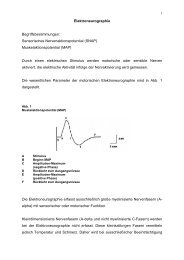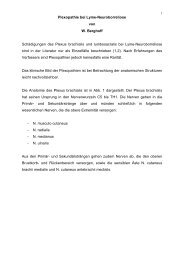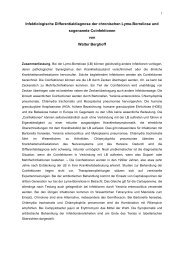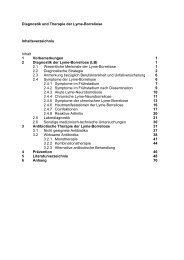Infectiologic differential diagnosis of chronic Lyme disease and so ...
Infectiologic differential diagnosis of chronic Lyme disease and so ...
Infectiologic differential diagnosis of chronic Lyme disease and so ...
You also want an ePaper? Increase the reach of your titles
YUMPU automatically turns print PDFs into web optimized ePapers that Google loves.
11<br />
Fig. 1. Erythrocytes infected with Bartonella henselae (Bh). A. Early stage, Bh<br />
on the outside <strong>of</strong> the erythrocytes; b. With increasing duration <strong>of</strong><br />
infection, Bh primarily intracellular; erythrocytes loose their lightcolored<br />
center.<br />
There is no information on the value <strong>of</strong> serology in the literature. In particular, the<br />
question as to whether seronegativity rules out the <strong>disease</strong> has not been clarified.<br />
On the other h<strong>and</strong>, as is the case for many other infectious <strong>disease</strong>s, a positive<br />
serological finding merely proves that an infection took place, but does not indicate<br />
that the <strong>disease</strong> currently exists.<br />
Detecting Bartonella in culture is extremely problematical, <strong>and</strong> the sensitivity is very<br />
low <strong>so</strong> that this method <strong>of</strong> investigation is not part <strong>of</strong> routine diagnostics.<br />
Detection <strong>of</strong> pathogens using PCR in biopsies appears to be very promising [87,<br />
232], but the investigation with PCR must follow the biopsy nearly immediately [88].<br />
The <strong>chronic</strong> course <strong>of</strong> bartonellosis has been described in numerous studies, in part,<br />
on large groups [90 - 94]. The long duration <strong>of</strong> the <strong>disease</strong>, which frequently covers<br />
many years, <strong>and</strong> the high similarity <strong>of</strong> the <strong>disease</strong> manifestations makes it extremely<br />
difficult to distinguish from <strong>chronic</strong> <strong>Lyme</strong> <strong>disease</strong>. Thus, bartonellosis is <strong>of</strong> great<br />
importance in the infectiologic <strong>differential</strong> <strong>diagnosis</strong> <strong>of</strong> <strong>Lyme</strong> <strong>disease</strong>.<br />
In this context, attention should be paid to the fact that B. henselae has been found<br />
in ticks <strong>and</strong> that the transmission <strong>of</strong> B. henselae by ticks has been documented by<br />
means <strong>of</strong> pathogen detection in the liquor [95]. Additionally, the prevalence <strong>of</strong> B.<br />
henselae in ticks is apparently high; scientific studies determined a prevalence <strong>of</strong><br />
40% [96].<br />
According to my own surveys, 78% <strong>of</strong> the patients with <strong>chronic</strong> <strong>Lyme</strong> <strong>disease</strong> proved<br />
to be seropositive for Bartonella henselae.













